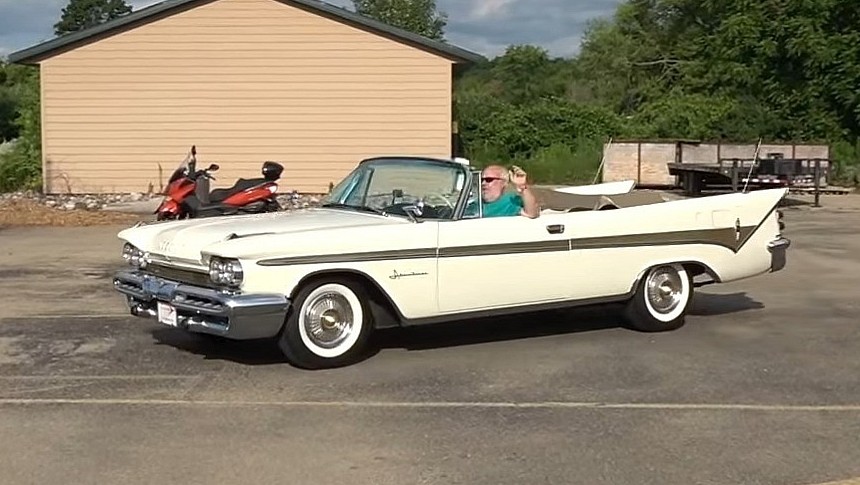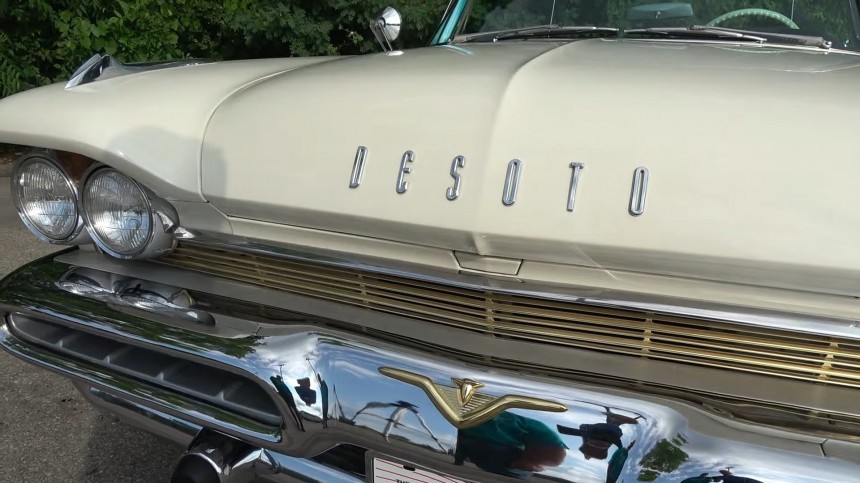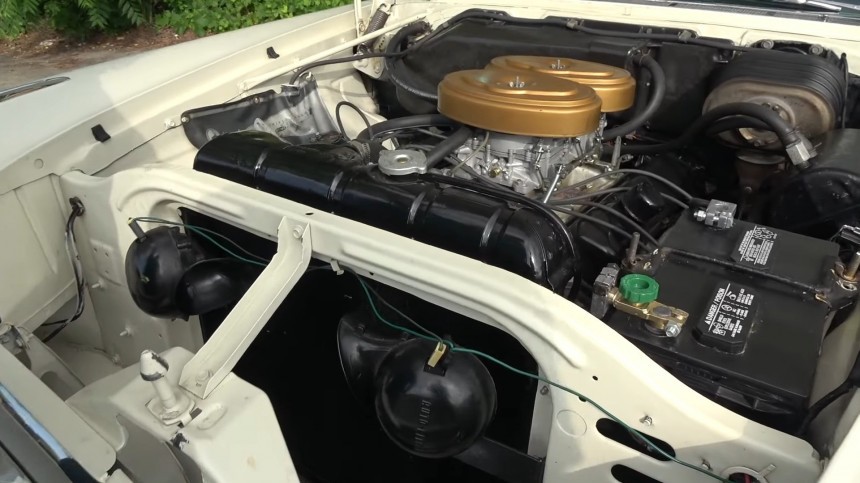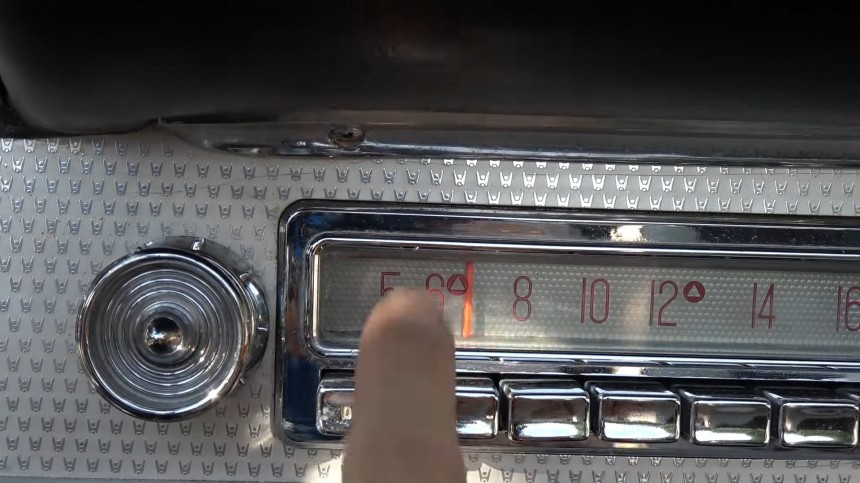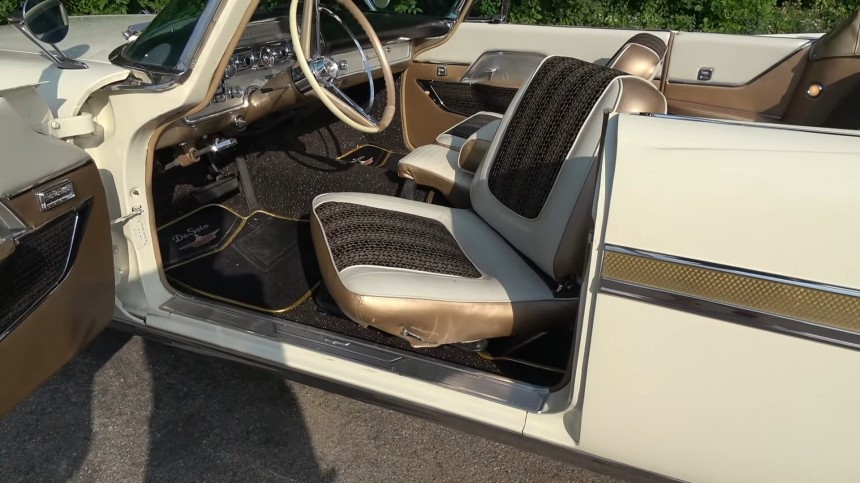In the mid-50s, performance was a staple of Chrysler's wrenching philosophy. Each of the five divisions had a powerhouse flagship: the letter Chrysler 300s, Plymouth’s Fury, and Dodge’s D-500. The other two brands - DeSoto and Imperial – didn’t waste any time joining the in-house fray. Although the DeSoto line was born as a low-end sub-brand within the Chrysler hierarchy in the late 20s, it made its way up the ladder.
When Virgil Exner’s Forward Look design ideology fired up, DeSoto proposed the Adventurer, adopting the same low-production specialty model concept as its sister divisions. Introduced in 1956, the fatefully-christened Adventurer had a short life – by 1961, it became history, together with the entire DeSoto brand.
In 1959, the automobile received a fresh look and a new engine – the long-running 383 CID (6.5-liter) V8. It also introduced the American public to a new concept of swiveling seats (a patent of Chrysler Corporation) – and this feature is demonstrated in the video attached to this story.
The automobile in question belongs to a long-time Mopar man with a knack for rare birds – and this 1959 DeSoto Adventurer in white and gold definitely fits the bill. Just 97 vehicles rolled out of the factory gates during the model year. The value expresses the number of convertible Adventurers built – the total was 687 (the bulk production focused on hardtops – 590 units).
The car is one of only fifteen believed to exist today; it has received a restoration in Sweden and made its way to America before entering the current owner’s Mopar collection. As we can plainly see, the engine wears the patina of regular road use – the sign of proper TLC.
After all, what’s the use of a twin-four-barrel carburetion on the big-block if it sits bone-dry and doesn’t get fresh air and exercise regularly? Ettore Bugatti – the founder of the House of Speed for the Obscenely Rich – left us a memorable mantra: “Cars are for driving, not stopping.”
The 383 V8 is – as we can hear and see in the video attached – going strong and sound 64 years after its first run. The three-speed TorqueFlite isn’t skipping a beat and puts the 350 hp (355 PS) down to the rear effortlessly.
The big engine wasn’t designed to rip apart rear tires with its cannonade of power and torque – DeSoto wasn’t all about roaring quarter-mile blasts. The car had a push-button three-speed automatic, for combustion’s sake, and its options list focused on comfort and relaxation.
While this particular doesn’t have it, there was an option of an automatic dimming rearview mirror – Chrysler called it, rather `kindergardenly,` Mirror-Matic Mirror. Speaking of peeking at the traffic behind, DeSoto offered dual side mirrors (remember, this was 1959 – the external mirrors were still optional). Not only that but they were remotely operated via a knob on the dashboard - their positioning far from the driver made it impossible to be adjusted by hand while seated.
Another cool feature of this car is the station-seeking floor button for the radio, to the inside of the high-beam dimming button (also foot-operated). The radio is the AM CONELRAD receiver that was common practice in the 50s, and it had everything to do with the Cold War. The two triangles at 640 and 1240 kHz mark the emergency broadcast frequencies the U.S. government would use in case of a nuclear attack.
Thankfully, that was never the case, and the remnants of an age long ago are just cool features on a magnificent automobile from a glorious era of Chrysler styling. Since we mentioned the cool factor, the Adventurer had plenty of it, thanks to its four-season push-button air conditioning system.
What the DeSoto Adventurer does not have is a tach; the dual four-barrel carburetors and `hi-lift special performance type’ camshaft were the secret weapons behind the 425 lb-ft of torque (576 Nm). Still, the Adventurer wasn’t bragging about it.
See it in the video: not a lot of dual exhaust thunder, but the body rocks when the right pedal gets the kick (double pun intended, yes). The standard rear on the TorqueFlite-equipped cars was a 3.31 semi-floating silent-hypoid differential, with an economy option of a 2.93 ratio gearing for better fuel economy.
Six decades ago, interior styling got a lot more attention from car designers than today, with a palette option that could rival a fashion designer’s studio. DeSoto wasn’t an exception – have a look at this example. And take a look at the speed ribbon: depending on what speed the car is going, the bar changes color from green (below 30 mph / 48 kph) to white (up to 55 mph / 88 kph) to red - and back, when the driver steps on the power brakes.
Again, the swiveling seats are one more argument that classics are far superior in appeal to anything from today (especially the dull touch-screen-armored monuments of boredom and safety bureaucracy from this millennium).
The Adventurer was offered only in Black or White – both with plenty of gold accents and chrome ornaments – but it was a price to be paid for such pampering and glamour. $4,749 in 1959 was anything but cheap: for reference, compare the 1959 Adventurer with that year’s best-seller, the first-generation stand-alone model Chevrolet Impala. GM’s offer cost $2,704, nearly half as much as the posh Chrysler.
In 1959, the automobile received a fresh look and a new engine – the long-running 383 CID (6.5-liter) V8. It also introduced the American public to a new concept of swiveling seats (a patent of Chrysler Corporation) – and this feature is demonstrated in the video attached to this story.
The automobile in question belongs to a long-time Mopar man with a knack for rare birds – and this 1959 DeSoto Adventurer in white and gold definitely fits the bill. Just 97 vehicles rolled out of the factory gates during the model year. The value expresses the number of convertible Adventurers built – the total was 687 (the bulk production focused on hardtops – 590 units).
After all, what’s the use of a twin-four-barrel carburetion on the big-block if it sits bone-dry and doesn’t get fresh air and exercise regularly? Ettore Bugatti – the founder of the House of Speed for the Obscenely Rich – left us a memorable mantra: “Cars are for driving, not stopping.”
The 383 V8 is – as we can hear and see in the video attached – going strong and sound 64 years after its first run. The three-speed TorqueFlite isn’t skipping a beat and puts the 350 hp (355 PS) down to the rear effortlessly.
While this particular doesn’t have it, there was an option of an automatic dimming rearview mirror – Chrysler called it, rather `kindergardenly,` Mirror-Matic Mirror. Speaking of peeking at the traffic behind, DeSoto offered dual side mirrors (remember, this was 1959 – the external mirrors were still optional). Not only that but they were remotely operated via a knob on the dashboard - their positioning far from the driver made it impossible to be adjusted by hand while seated.
Another cool feature of this car is the station-seeking floor button for the radio, to the inside of the high-beam dimming button (also foot-operated). The radio is the AM CONELRAD receiver that was common practice in the 50s, and it had everything to do with the Cold War. The two triangles at 640 and 1240 kHz mark the emergency broadcast frequencies the U.S. government would use in case of a nuclear attack.
What the DeSoto Adventurer does not have is a tach; the dual four-barrel carburetors and `hi-lift special performance type’ camshaft were the secret weapons behind the 425 lb-ft of torque (576 Nm). Still, the Adventurer wasn’t bragging about it.
See it in the video: not a lot of dual exhaust thunder, but the body rocks when the right pedal gets the kick (double pun intended, yes). The standard rear on the TorqueFlite-equipped cars was a 3.31 semi-floating silent-hypoid differential, with an economy option of a 2.93 ratio gearing for better fuel economy.
Again, the swiveling seats are one more argument that classics are far superior in appeal to anything from today (especially the dull touch-screen-armored monuments of boredom and safety bureaucracy from this millennium).
The Adventurer was offered only in Black or White – both with plenty of gold accents and chrome ornaments – but it was a price to be paid for such pampering and glamour. $4,749 in 1959 was anything but cheap: for reference, compare the 1959 Adventurer with that year’s best-seller, the first-generation stand-alone model Chevrolet Impala. GM’s offer cost $2,704, nearly half as much as the posh Chrysler.
